- Home
- About
- Map
- Trips
- Bringing Boat West
- Migration West
- Solo Motorcycle Ride
- Final Family XC Trip
- Colorado Rockies
- Graduates' XC Trip
- Yosemite & Nevada
- Colorado & Utah
- Best of Utah
- Southern Loop
- Pacific Northwest
- Northern Loop
- Los Angeles to NYC
- East Coast Trips
- Martha's Vineyard
- 1 Week in Quebec
- Southeast Coast
- NH Backpacking
- Martha's Vineyard
- Canadian Maritimes
- Ocracoke Island
- Edisto Island
- First Landing '02
- Hunting Island '02
- Stowe in Winter
- Hunting Island '01
- Lake Placid
- Chesapeake
- Provincetown
- Hunting Island '00
- Acadia in Winter
- Boston Suburbs
- Niagara Falls
- First Landing '99
- Cape Hatteras
- West Coast Trips
- Burning Man
- Utah Off-Roading
- Maui
- Mojave 4WD Course
- Colorado River Rafting
- Bishop & Death Valley
- Kauai
- Yosemite Fall
- Utah Off-Road
- Lost Coast
- Yosemite Valley
- Arizona and New Mexico
- Pescadero & Capitola
- Bishop & Death Valley
- San Diego, Anza Borrego, Joshua Tree
- Carmel
- Death Valley in Fall
- Yosemite in the Fall
- Pacific Northwest
- Utah Off-Roading
- Southern CA Deserts
- Yosemite & Covid
- Lake Powell Covid
- Eastern Sierra & Covid
- Bishop & Death Valley
- Central & SE Oregon
- Mojave Road
- Eastern Sierra
- Trinity Alps
- Tuolumne Meadows
- Lake Powell Boating
- Eastern Sierra
- Yosemite Winter
- Hawaii
- 4WD Eastern Sierra
- 4WD Death Valley +
- Southern CA Deserts
- Christmas in Tahoe
- Yosemite & Pinnacles
- Totality
- Yosemite & Sierra
- Yosemite Christmas
- Yosemite, San Diego
- Yosemite & North CA
- Seattle to Sierra
- Southwest Deserts
- Yosemite & Sierra
- Pacific Northwest
- Yosemite & South CA
- Pacific Northwest
- Northern California
- Southern Alaska
- Vancouver Island
- International Trips
- Index
- Tips
- Books
- Photos/Videos
- Search
- Contact
Waterton-Glacier National Park, MT
Thursday, July 20, 2000 - 1:00pm by Lolo
800 miles and 17 hours from our last stop - 4 night stay
Travelogue
We were very pleasantly surprised to find out that the map program's 17-hour estimate of the time it would take us to get to Glacier from Theodore Roosevelt was way over. Rather than the 40 mph speed it used, we were able to cruise along the 700 miles across Montana at 65 mph, getting us there in under 12 hours--still a very long day. The drive through Montana was much different than I expected, flat, dry, and somewhat boring. Where were the mountains? The blue sky? I hadn't realized that most of Montana was plains and that it stayed that way until you hit Glacier all the way in the western part of the state. Most of the ride was on Route 2, a two-lane highway with no divider, with only a handful of small towns scattered along the way. This was cattle ranch country and every 20 minutes or so we would pass the entrance to another ranch, with names like Big Timber, Three Forks, Round Up, etc. Sometimes we would drive for almost an hour without seeing another car. Then, and this is Herb's favorite part, we would pass a pickup truck and the driver never failed to wave and give us a big smile. Herb was skeptical at first as to why they were waving--was something wrong with the RV? Were they trying to tell us something? After a few more waving ranchers, we realized that they were just being friendly, happy to see another human being on this lonely stretch of road.
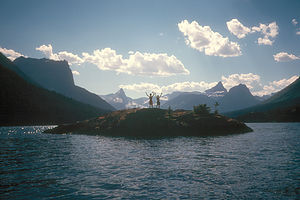 Kid's on Island in St Mary's LakeFinally, after many, many hours of driving, we were thrilled to see the tall, jagged, snow-covered mountain peaks in the distance which meant that we were finally getting close to Glacier. We were going to make it a day ahead of schedule--a bonus day--and fortunately, the St. Mary's KOA where we had reservations for the next couple of days had room for us that night. Tommy was appalled when he saw the campground. There were RVs all around, kids riding bikes, and not a buffalo in sight--not anything like the peace and solitude of our campsite at Theodore Roosevelt. I told Tom about the hot tub and the volleyball court, but that didn't do. Not even the mention of a gift shop could cheer him up--this was serious. How was I supposed to know that he was going to morph into "Nature Tom" this trip. We had chosen to stay here rather than inside the park because besides the hot tub and activities that we thought the kids would enjoy, we could also rent a Suburban to take on the RV-restricted Going to the Sun Road through the park. Tom got over it soon enough, but Herb and I were actually quite happy that he had been able to appreciate what the natural beauty of T.R. had to offer.
Kid's on Island in St Mary's LakeFinally, after many, many hours of driving, we were thrilled to see the tall, jagged, snow-covered mountain peaks in the distance which meant that we were finally getting close to Glacier. We were going to make it a day ahead of schedule--a bonus day--and fortunately, the St. Mary's KOA where we had reservations for the next couple of days had room for us that night. Tommy was appalled when he saw the campground. There were RVs all around, kids riding bikes, and not a buffalo in sight--not anything like the peace and solitude of our campsite at Theodore Roosevelt. I told Tom about the hot tub and the volleyball court, but that didn't do. Not even the mention of a gift shop could cheer him up--this was serious. How was I supposed to know that he was going to morph into "Nature Tom" this trip. We had chosen to stay here rather than inside the park because besides the hot tub and activities that we thought the kids would enjoy, we could also rent a Suburban to take on the RV-restricted Going to the Sun Road through the park. Tom got over it soon enough, but Herb and I were actually quite happy that he had been able to appreciate what the natural beauty of T.R. had to offer.
We woke up early the next morning determined to make the best of our bonus day. We just needed to get back to the campground by dinner to meet up with our friends from New Jersey, the Kalchbrenners, who had traveled with us the previous year, and had decided to come back for more. They rented an RV from Cruise America in Idaho and were making the long drive to Glacier that day. The plan was for them to spend the Glacier/Yellowstone portion of our trip with us.
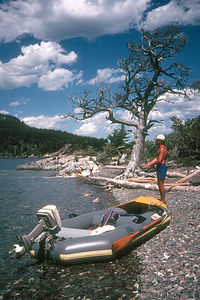 Herb with Avon at St Mary's LakeWe decided to spend the morning exploring the Many Glacier section of the park. Along the Many Glacier Road we just had to pull over when we got our first glimpse of the aquamarine waters of one of the park's many glacial lakes, Lake Shelburne, set at the base of a jagged, snow-covered mountain. After some photos, we continued on to the Many Glacier Hotel at the end of the road. I don't think I've ever met a National Park hotel I didn't like. This one was in the style of a Swiss Chalet and was perched at the edge of the glacial Swift Current Lake, surrounded, as we've come to expect here, by awesome glacier-covered mountain peaks. I wasted no time making dinner reservations for us and the Kalchbrenners the following evening.
Herb with Avon at St Mary's LakeWe decided to spend the morning exploring the Many Glacier section of the park. Along the Many Glacier Road we just had to pull over when we got our first glimpse of the aquamarine waters of one of the park's many glacial lakes, Lake Shelburne, set at the base of a jagged, snow-covered mountain. After some photos, we continued on to the Many Glacier Hotel at the end of the road. I don't think I've ever met a National Park hotel I didn't like. This one was in the style of a Swiss Chalet and was perched at the edge of the glacial Swift Current Lake, surrounded, as we've come to expect here, by awesome glacier-covered mountain peaks. I wasted no time making dinner reservations for us and the Kalchbrenners the following evening.
I had read that grizzlies were pretty common in this area, so I refused to hike until we had purchased some bear bells in the gift shop. The theory behind these bear bells, which look an awful lot like sleigh bells, is that the bears really don't want to eat you, so if they hear you coming, they'll run away. I'm not sure if I like the idea of the bear knowing where I am when I don't know where he is, but we figured they knew what they were talking about. We hiked the very scenic 2.5-mile loop trail around Swift Current Lake, me wildly jingling the bells the entire way. Great hike, and no bears. Maybe the bells do work.
We found out that we could drive our RV on the Going to the Sun Road as far as St. Mary's Lake, so we headed back down to the St. Mary's entrance to the park and drove along the shores of St. Mary's Lake, yet another aquamarine, glacial lake, complete with surrounding snow-capped mountains. Taking pictures of it was not going to be enough this time; we just had to get the boat out on it.
We immediately drove down to the Rising Sun boat launch and assembled our 12-foot inflatable Avon raft and 6 hp motor. As we putted out into the lake, there was a fair number of people watching us--I'm not sure if they thought we were crazy or whether they were envious. It was extremely windy and the lake water was ice cold (probably about 48 degrees), so we knew we had to be careful because you could get hypothermic real quick in this water.
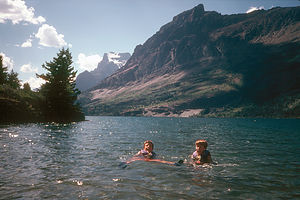 Cold swim in St Mary's LakeWe headed across the lake to what looked like a small beach. The kids had brought their spinning rods along, so they spent some time wandering up and down the bushes along the shore casting, sometimes hitting the water, more often getting caught in the bushes. In one of the casts that actually made it to the water, Andrew pulled in his first rainbow trout--not exactly a lunker, but a Montana rainbow trout nonetheless.
Cold swim in St Mary's LakeWe headed across the lake to what looked like a small beach. The kids had brought their spinning rods along, so they spent some time wandering up and down the bushes along the shore casting, sometimes hitting the water, more often getting caught in the bushes. In one of the casts that actually made it to the water, Andrew pulled in his first rainbow trout--not exactly a lunker, but a Montana rainbow trout nonetheless.
Unable to avoid the temptation, we decided to go for what turned out to be a very quick dip. You had to do it fast--there was no gradual entry into this water. We all ran in quickly dunking ourselves. The water was so frigid that our bodies tingled all over. At least it felt warm when we got out.
When we got back in the boat, the kids convinced us to drop them off at a rock island in the middle of the lake so that we could take their pictures. This is probably one of my favorite photos of all time--the kids standing arms raised and legs spread, silhouetted against the snow-covered jagged peaks behind them, the only people in sight for miles.
What a great day! Another great boating experience. That was two already this trip--first Pictured Rocks and now this. The boat was certainly earning its keep and providing us with some major trip highlights.
Back at the campground that night, we did some serious hot tubbing and waited for the Kalchbrenners to arrive. The drive from Idaho took quite a bit longer than anticipated, so they didn't get into the campground until after 9:00, quite tired and hungry. Fortunately, this KOA served pizzas and burgers until 10:00 every night, so they were able to grab a bite to eat. Despite their long, tiring travel day, the Kalchbrenners were excited about being in this terrific place and ready for a week of adventure.
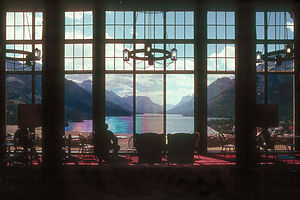 Lobby view inside Prince of Wales HotelThe next morning, we picked up our rental suburban at the campground office, which I had reserved weeks in advance, and headed back into the park to drive the scenic 50-mile Going to the Sun Road. St. Mary's Lake appeared different to us this time--not just another incredible sight, but something more familiar that we had been fortunate enough to personally experience in our little boat the day before. The road continued on through meadows before it began to climb. We stopped at the Jackson Glacier Overlook to see one of the few glaciers visible from the road. Unfortunately, in the last 50 years, it has shrunk to ¼ its size. It's sad to think that someday, maybe even in our lifetime, many of these glaciers will be gone, remembered only by the beautiful mountains, valleys, and basins that they helped to carve. We continued on to Logan Pass, atop the Continental Divide. From here we took a great 3-mile roundtrip hike to the Hidden Lake Overlook.
Lobby view inside Prince of Wales HotelThe next morning, we picked up our rental suburban at the campground office, which I had reserved weeks in advance, and headed back into the park to drive the scenic 50-mile Going to the Sun Road. St. Mary's Lake appeared different to us this time--not just another incredible sight, but something more familiar that we had been fortunate enough to personally experience in our little boat the day before. The road continued on through meadows before it began to climb. We stopped at the Jackson Glacier Overlook to see one of the few glaciers visible from the road. Unfortunately, in the last 50 years, it has shrunk to ¼ its size. It's sad to think that someday, maybe even in our lifetime, many of these glaciers will be gone, remembered only by the beautiful mountains, valleys, and basins that they helped to carve. We continued on to Logan Pass, atop the Continental Divide. From here we took a great 3-mile roundtrip hike to the Hidden Lake Overlook.
The hike started out on a boardwalk through a glacier-carved basin of rock terraces. Although not actually a glacier, the entire area was still covered in snow, much to the kids' delight. Snow in July was something new and not to be passed up. After about a half hour, they reluctantly finished their snowball fight so that we could continue our hike to the overlook. When we got to the end, we were greeted by several very friendly Dahl sheep who willingly posed for their pictures. Jonathan blew an entire roll of film on them. We ate a picnic lunch, perched at the edge of the hanging valley that overlooked Hidden Lake.
After Logan Pass, the road started to descend past a knife-edged wall of rock called the Garden Wall and then doubled back on itself in the tightest hairpin turn I have ever experienced. The map referred to this turn as The Loop--Jonathan named it the "Haiwy Turn." We descended into the McDonald Valley and stopped at the northern end of McDonald Lake, the largest lake in the park, before turning around to go back.
That night we had a great dinner at the Many Glacier Hotel. After dinner, we stepped out onto the porch to enjoy the scenery of the lake and mountains. The brief storm that we had heard while eating dinner had added a rainbow to the already incredible view.
The next day we drove up the Chief Mountain International Highway to Waterton Lakes, the Canadian counterpart to Glacier. We stopped at the Visitor Center and from there hiked the Bear Hump Trail to a great panoramic view of the area. It was so windy on top that we had to crouch down to stop from being blown over. In the distance we could see the majestic, alpine-style Prince of Wales Hotel sitting on a bluff overlooking Upper Waterton Lake. It's one of the most photographed hotels in the world, and I can certainly see why.
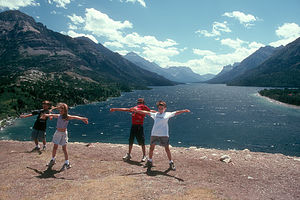 Kids in Wind on Bluff by Prince of Wales HotelIt was Tommy's 9th birthday, so we decided to celebrate with a lunch at the Prince of Wales Hotel. Fearing that we wouldn't be able to get a table, we hurried down to get there by noon, only to find a completely empty dining room. Unknown to us, Canada did not practice daylight savings time, so it was actually only 11:00 their time, way ahead of the lunch crowd. We were seated at the best table in the house, next to the giant picture windows overlooking the lake. Actually, we were seated at two tables. Rather than sitting on one long table where it's hard to converse, we find that splitting up into an adult table and a kids table works out great. The view was so incredible that I hardly even remember what I ate. What I do remember most is Tommy's expression when the waitress brought out four giant sundaes for the kid table, and the entire dining room, which had by now completely filled, sang Happy Birthday to him.
Kids in Wind on Bluff by Prince of Wales HotelIt was Tommy's 9th birthday, so we decided to celebrate with a lunch at the Prince of Wales Hotel. Fearing that we wouldn't be able to get a table, we hurried down to get there by noon, only to find a completely empty dining room. Unknown to us, Canada did not practice daylight savings time, so it was actually only 11:00 their time, way ahead of the lunch crowd. We were seated at the best table in the house, next to the giant picture windows overlooking the lake. Actually, we were seated at two tables. Rather than sitting on one long table where it's hard to converse, we find that splitting up into an adult table and a kids table works out great. The view was so incredible that I hardly even remember what I ate. What I do remember most is Tommy's expression when the waitress brought out four giant sundaes for the kid table, and the entire dining room, which had by now completely filled, sang Happy Birthday to him.
After lunch we walked out on the lawn outside the dining room to the edge of the bluff overlooking the lake. The winds coming off the lake were so incredibly strong that we had to stoop down into them to walk. If they had been blowing in the other direction, we would have flown right off the edge for sure. It was exhilarating. We captured the moment in one of my favorite photos of all time--the four kids, arms and legs spread, leaning backwards into the wind, looking like they would tip off the edge if the wind stopped. I don't think the wind ever stops here. In fact, the locals say that they only consider it windy when there are whitecaps in the toilets at the Prince of Wales Hotel.
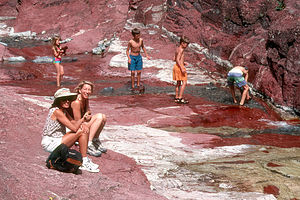 Ladies and Kids in Red CanyonBack in the RV, we drove the 10-mile Red Canyon Parkway to the end where there was a stream flowing over the red rock that the canyon is named for. Michelle and I lounged on the red rock ledges that had been nicely warmed by the sun, while the kids swam in the chilly waters of the stream. In the meantime, Herb and Hans went for a hike into the canyon. They had been gone for awhile, when I overhead some hikers say that there was a grizzly spotted along the trail. I started to panic. Hadn't they been gone an awfully long time? Michelle and I started to worry that something had happened to them. I think they were quite surprised by the warmer than usual greeting they got upon their return. They were totally unaware that a grizzly had been spotted.
Ladies and Kids in Red CanyonBack in the RV, we drove the 10-mile Red Canyon Parkway to the end where there was a stream flowing over the red rock that the canyon is named for. Michelle and I lounged on the red rock ledges that had been nicely warmed by the sun, while the kids swam in the chilly waters of the stream. In the meantime, Herb and Hans went for a hike into the canyon. They had been gone for awhile, when I overhead some hikers say that there was a grizzly spotted along the trail. I started to panic. Hadn't they been gone an awfully long time? Michelle and I started to worry that something had happened to them. I think they were quite surprised by the warmer than usual greeting they got upon their return. They were totally unaware that a grizzly had been spotted.
We spent our last night at Glacier relaxing around the campground--more hot tubbing and a pickup volleyball game that kept growing as more families wandered by and joined in the fun. Our visit to Waterton-Glacier had more than lived up to our expectations.
Description
In 1932, Glacier National Park in northwestern Montana and Waterton Lakes National Park in Alberta, Canada united to become the world’s first international peace park. Together they encompass more than 2,000 square miles of jagged, glacier-covered mountain peaks, 650 ice-cold glacial lakes, numerous waterfalls, beautiful forested valleys, and more than 800 miles of hiking trails.
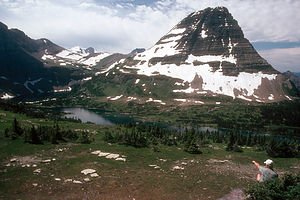 Hidden Lake at Logan PassThis area was once part of the plains until about 60 million years ago when the North American continent collided with the Pacific Ocean floor, pushing giant rock layers over the softer, younger rock layers in the plains to the east, creating the 300-mile-long Lewis Overthrust. The landscape was further sculpted during the Ice Age by giant glaciers that shaped and dug the deep valleys, basins, and lakes and carved the mountains into thin, jagged ridges. Today there are no glaciers left in Waterton Lakes, and those remaining in Glacier are gradually shrinking each year.
Hidden Lake at Logan PassThis area was once part of the plains until about 60 million years ago when the North American continent collided with the Pacific Ocean floor, pushing giant rock layers over the softer, younger rock layers in the plains to the east, creating the 300-mile-long Lewis Overthrust. The landscape was further sculpted during the Ice Age by giant glaciers that shaped and dug the deep valleys, basins, and lakes and carved the mountains into thin, jagged ridges. Today there are no glaciers left in Waterton Lakes, and those remaining in Glacier are gradually shrinking each year.
The major activities in the park include hiking the more than 800 miles of hiking trails, boating and fishing in the lakes (motor size limited to 10 hp), and wildlife viewing (moose, elk, bighorn sheep, mountain goats, black bear, grizzly bear). Although there are numerous lakes, they are glacial, so the water is too cold for swimming.
Going to the Sun Road (Glacier)
An excellent way to see many of the park’s highlights is to drive the scenic 50-mile Going to the Sun Road, which crosses the park from West Glacier to St. Mary’s, climbing more than 3,400 feet. Since the road is so winding and narrow, vehicles over 21-feet long are prohibited. However, rental cars are available at West Glacier and St. Mary’s,
Starting from the west, the road hugs the shore of 10-mile-long Lake McDonald (largest lake in the park), past McDonald Falls, and then climbs to the high country along the jagged cliffs of the Garden Wall to its highest point, Logan Pass atop the Continental Divide.
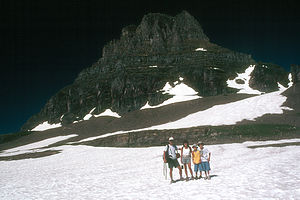 Family at Logan PassA very popular hike from the Logan Pass Visitor Center is the moderately strenuous 3-mile roundtrip Hidden Lake Nature Trail, which climbs 800 feet on a series of boardwalks to a beautiful overlook of Hidden Lake. Along the way the trail crosses the Hanging Gardens of Logan Pass, which is an area filled with wildflowers and surrounded by jagged mountain peaks. There is usually snow alongside the trail all year long. At the Hidden Lake Overlook, you are almost guaranteed to see mountain goats.
Family at Logan PassA very popular hike from the Logan Pass Visitor Center is the moderately strenuous 3-mile roundtrip Hidden Lake Nature Trail, which climbs 800 feet on a series of boardwalks to a beautiful overlook of Hidden Lake. Along the way the trail crosses the Hanging Gardens of Logan Pass, which is an area filled with wildflowers and surrounded by jagged mountain peaks. There is usually snow alongside the trail all year long. At the Hidden Lake Overlook, you are almost guaranteed to see mountain goats.
After leaving Logan Pass, the road starts to steeply descend, passing Going to the Sun Mountain (the highest peak in the park), Jackson Glacier (one of the few glaciers visible from the road), and Going to the Sun Point, where there are fabulous vistas of St. Mary’s Lake. The road comes to an end at the St. Mary’s entrance to the park.
Many Glacier (Glacier)
The Many Glacier section of the park is reached from the town of Babb, about 10 miles north of St. Mary’s. It got its name from the six glaciers that cover the surrounding mountains. It is a hiker’s paradise as well as a good place to spot wildlife, such as bighorn sheep and mountain goats. Grizzly bears are also quite common in this area.
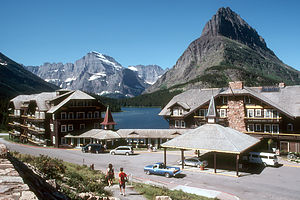 Many Glacier HotelA very popular hike in Many Glacier is the 2.5-mile loop trail around Swift Current Lake. Another popular, but much longer hike from this area, is the 11-mile roundtrip hike to Grinnell Glacier, one of the largest and most accessible glaciers in the park.
Many Glacier HotelA very popular hike in Many Glacier is the 2.5-mile loop trail around Swift Current Lake. Another popular, but much longer hike from this area, is the 11-mile roundtrip hike to Grinnell Glacier, one of the largest and most accessible glaciers in the park.
A wonderful place for lodging or dinner in this area is the picturesque, alpine-style Many Glacier Hotel, which was built in 1915 by the Great Northern Railway in an attempt to promote tourism. This Swiss Chalet type hotel is the most photographed building in the park. From the lobby and dining room, there are tremendous views of the mountains and lake.
Waterton Lakes
Waterton Lakes, the Canadian counterpart to Glacier, is reached by driving the 75-mile Chief Mountain Highway from the town of Babb across the border to Waterton Village. There is no real park center at Waterton, but rather a scattering of facilities in the Village. The park’s main visitor information center is on the right about 4 miles past the entrance to the park. A popular hike from the Visitor Center is the 1.5-mile roundtrip Bears Hump Trail, which climbs to a great panoramic view of the area.
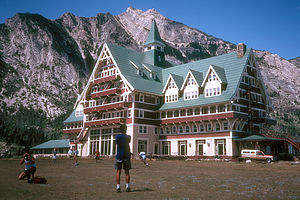 Prince of Wales HotelNear the Visitor Center is the historic and majestic Prince of Wales Hotel, one of the most photographed hotels in the world. Like the Many Glacier Hotel, this alpine-style hotel was built by the Great Northern Railway in 1927. It sits on top of a bluff looking out over Upper Waterton Lake. From the two-story high picture windows in the lobby and dining room, the views are incredible. In true British tradition, British high tea is served every afternoon at 3:00. A short walk out to the edge of the bluff overlooking the lake, let’s you experience the incredible gusts of wind that are common here. In fact, it is so windy here that locals only acknowledge that it’s windy when there are whitecaps in the toilets at the Prince of Wales Hotel.
Prince of Wales HotelNear the Visitor Center is the historic and majestic Prince of Wales Hotel, one of the most photographed hotels in the world. Like the Many Glacier Hotel, this alpine-style hotel was built by the Great Northern Railway in 1927. It sits on top of a bluff looking out over Upper Waterton Lake. From the two-story high picture windows in the lobby and dining room, the views are incredible. In true British tradition, British high tea is served every afternoon at 3:00. A short walk out to the edge of the bluff overlooking the lake, let’s you experience the incredible gusts of wind that are common here. In fact, it is so windy here that locals only acknowledge that it’s windy when there are whitecaps in the toilets at the Prince of Wales Hotel.
There are two different drives into the park. The Akamina Parkway is a 10-mile-long drive from the Visitor Center through the Cameron Valley to Cameron Lake, which lies in a large glacier-carved basin. The 2-mile-long Cameron Lakeshore Trail takes you through forests around the lake. There are many grizzlies in the area.
The 10-mile-long Red Rock Canyon Parkway starts about 2 miles north of the Visitor Center and takes you along the Blackstone Creek to Red Rock Canyon, where there is a beautiful stream flowing over the red rock that the canyon is named for. The water is cold, but fun to swim in. The .5 mile Red Rock Canyon Loop hiking trail takes you past waterfalls and into the canyon. There are also many grizzlies in this area.
- ‹ previous
- 9 of 25
- next ›
Waterton-Glacier National Park location map in "high definition"
Javascript is required to view this map.

I read an article, once, in the Porcupine Press (our Yooper magazine) about bears. Your kids would have liked it. It was a long article. The first part of the article, one whole page, was on safety tips. It advised pepper spray and bells. The second part of the article was about how to differentiate between grizzly bear scat and black bear scat. It said that black bear scat contained berries and smelled mild. Grizzly bear scat contained bells and smelled like pepper.